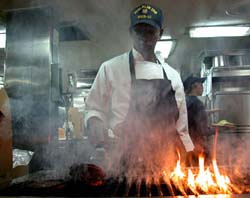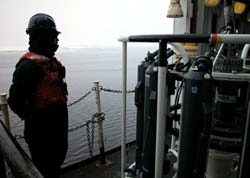|
|
 |
 |
 |
| It’s tough
cooking for 164 people! Chef Mark Goitia cooks burgers for the
popular Saturday lunch. |
|
Click to enlarge |
Daily Update
Calendar
Dispatch 06 - July 20, 2002
By C.A. Linder
Weather conditions: fog, calm winds and seas, air temperature 40° F
A Sea of White
Yesterday we felt like we were in the Caribbean, but there is no question now that we are in the Arctic. This morning we got our first indication when the loudspeaker blared “Polar bear, port side!” Immediately a crush of people scampered to vantage points on the decks. Only the observers high on the bridge saw the bear, though, before we left it far behind in our wake. Small bits of ice continued to drift past through the morning and early afternoon, and by dinnertime the ice was thick around us. And what a sight it is! It is defies description; there is nothing back home in New England I can compare it to...
At first glimpse, the seascape seems to be bleak and featureless. Why, then, did I stand, transfixed, at the bow for about four hours, taking photo after photo until I could barely feel my fingers? I imagine I felt today what astronauts must feel when they get launched into space. I have left the world of the familiar and the known. In that short four hours observing from the bow, I was amazed to see both a fogbow (like a rainbow, except it’s a colorless arc visible to someone looking down on fog lit by the sun) and a Specter of the Brocken (a small halo of light which formed around the shadow of my own head). The ice itself is mysteriously hypnotic - you just can’t stop watching it. The wind and waves carve odd shapes into the snow, and the ice ranges in color from a deep aquamarine blue to stark white to muddy brown. As the ship’s bow smashes into the larger floes, cracks appear and knife through the slabs of ice before they are thrust aside.
 |
 |
|
Marine Science Technician Chief Sean McPhilamy checks the conditions for the first CTD cast in the ice.
|
|
Click to enlarge |
The ice certainly has had an impact on our science operations as well. The CTD casts we practiced so well the night before are now dependent on the vagaries of the wind and ice. The goal is to find a spot where there is as much open water as possible, and then maneuver the port (CTD) side of the ship to the wind. The ship then behaves like a giant sail, and blows away from the ice. That’s the theory; but the winds and ice are seldom so cooperative, and it can take a long time to position the ship for a safe CTD cast.
Many of the crew and science party joined me at the bow to watch the slow drift of the ice. Their expressions mirrored my own. “Wow.” “Amazing.” “Incredible.” My shutter wasn’t the only one that was clicking, especially when a large polar bear lumbered off into the ice about a half mile from us, casting suspicious glances at the large noisy intruder. Last night in the gym a sailor told me he had begged to get assigned to the Polar Star. Who wouldn’t want to visit another world?
Click here to see some National Weather Service satellite images showing the extent of the ice in the Chukchi Sea.
 Previous Dispatch
Next Dispatch Previous Dispatch
Next Dispatch

Back to Calendar
|
|




